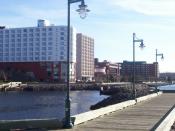As Ignatieff states that "Abundance has awakened us to denials of self while blinding us to poverty. We idly suppose that the poor have disappeared. They haven't. They simply become invisible" (92). He further explains "Abundance changes the moral economy of a society by favouring values of consumption over saving" (91). It implies that abundance causes the side effects of poverty because societies of abundance don't care about the ability of living on poor. These kinds of people are considered to be the invisible poor since they may have a limited amount of money for living. Alistair Macleod presents the increasing invisibility of poverty in his novel No Great Mischief through the living standards, education, working conditions and thoughts of his characters.
At the beginning of the book No Great Mischief, Alexander goes to visit his brother Calum in downtown Toronto. On Queen Street, he sees "In the grimy windows hand-lettered cardboard signs offer almost everything, it seems, at less than its true worth" (No Great Mischief 4), indicating the conditions of despair that Calum is forced to live in as he is unable to support himself.
Also, Alistair Macleod mentions that only few of the people who live in the building in Queen Street West are the owners of the stores beneath them. The people who live in this building experience bad living conditions: they share a small bathroom on a floor, a corridor with a dim light bulb and have the scarcity of hot water.
The novel No Great Mischief is set in Cape Breton, Nova Scotia. Calum's family like Calum and his brothers lack of a proper education and therefore are working in low-income jobs that result in an invisible poverty. A person who is lacking an education has a lesser chance of meeting their...


